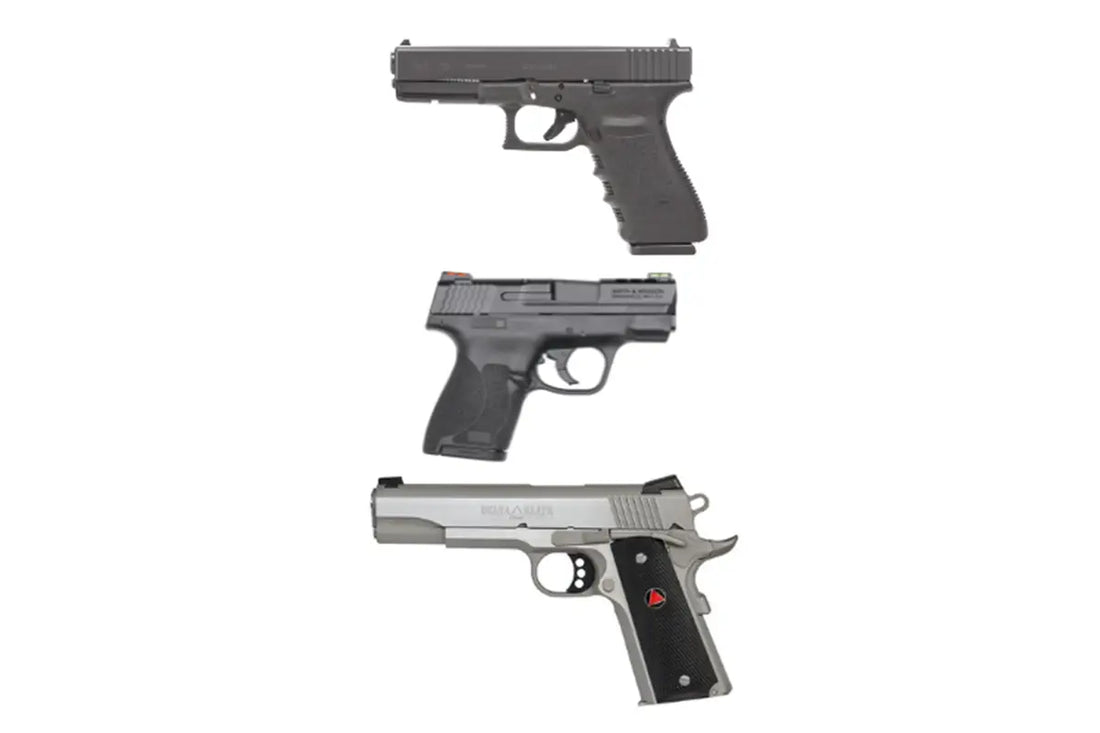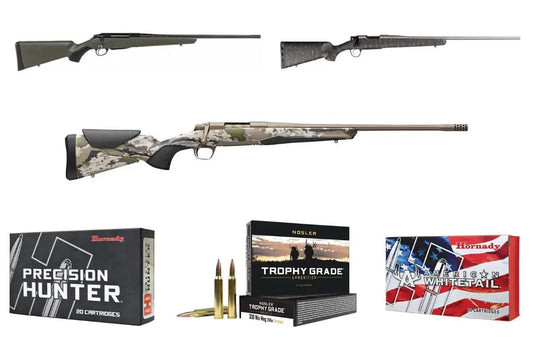
10 mm Auto vs. .40 S&W – The Heavy-Hitter Cage Match You Actually Care About
|
Quick-Look Spec Sheet |
10 mm Auto |
.40 S&W |
|
Typical bullet weight range |
135 – 220 gr |
135 – 200 gr |
|
Factory-loaded muzzle velocity (common duty loads) |
1,050 – 1,350 fps |
950 – 1,130 fps |
|
Factory-loaded muzzle energy |
550 – 775 ft-lb (Underwood 155 gr XTP: 775 ft-lb) |
360 – 510 ft-lb (Federal HST 180 gr: 408 ft-lb) |
|
SAAMI max pressure |
37,500 psi |
35,000 psi |
|
Parent case |
– |
Shortened 10 mm |
|
Same-size-frame duty gun example |
Glock 20 Gen5 MOS (15+1 rds) |
Glock 22 Gen5 (15+1 rds) |
|
Felt recoil in similar-weight guns (subjective) |
~7–9 ft-lb, “.357 Mag-class” snap |
~5–6 ft-lb, midway between 9 mm & .45 |
|
Typical street price per 50-rd FMJ (June 2025) |
$29–$42 |
$20–$28 |
|
Typical barrel length for energy quoted |
4.5–5.0″ |
4.0″ |
TL;DR for Skimmers
The 10 mm Auto is the decisive winner if you want magnum-level punch in an autopistol, woods-defense credibility, and hand-loading headroom.
The .40 S&W still reigns where controllability, duty-size guns, and cheap training ammo matter. If you’ll never push past two-legged threats under 25 yards, or you need a slim-frame CCW that prints like a 9 mm, the .40 delivers 75 % of the energy with 65 % of the recoil—hard to hate. Serious bear country? Hot 10 mm or bust.
“The 10 mm was conceived as the flat-shooting, deep-striking answer to autopistol mediocrity.” – Col. Jeff Cooper, circa 1986
“.40 S&W bridged the capacity gap between 9 mm and .45, and it still does exactly that.” – Massad Ayoob, firearms author & trainer
Below, you’ll find a ruthlessly opinionated, data-driven comparison of these fraternal twins. We’ll look at ten battlegrounds—ballistics, real-world terminal results, shootability, gun platforms, ammo economics, and more—so you can stop doom-scrolling and start buying.
Genesis Stories—Why They Exist at All
|
10 mm |
.40 S&W |
|
|
Birth |
1983, Dornaus & Dixon/Norma/Bren Ten partnership to deliver Cooper’s “.40 cal Magnum” in a 1911-like pistol. |
1990, Smith & Wesson + Winchester shorten 10 mm 2 mm so it fits 9 mm-size frames after FBI agents hated full-house 10 mm recoil. |
|
Early adopters |
FBI HRT (briefly), elite European LE, Alaska bush pilots. |
Every U.S. police cruiser from 1995 to 2015, plus millions of CCW carriers. |
|
Current trend |
Resurgence thanks to Glock 20/29 Gen5, SIG P320-XTEN, S&W M&P 10 mm, and boutique ammo hitting 750 + ft-lb. |
Stabilized niche: agencies leaving for 9 mm, but civilian shooters scooping up used LE pistols at bargain prices. |
Verdict: The 10 mm’s comeback is real; market availability is at a 20-year high. .40’s golden age is past, but that means deals.
2. Raw Ballistics—Energy, Velocity & Momentum
Example Full-Power Loads (5″ barrel for 10 mm, 4″ for .40):
- Underwood 10 mm 155 gr XTP: 1,500 fps, 775 ft-lb
- Underwood 10 mm 200 gr XTP: 1,250 fps, 694 ft-lb
- Federal HST .40 S&W 180 gr: 1,010 fps, 408 ft-lb
10 mm routinely doubles 9 mm energy and exceeds .357 Mag from a 4.6″ barrel; .40 clusters between hot 9 mm +P+ and mild .45 ACP +P. If your metric is kinetic joules per shot, 10 mm wins by ~70 %.
Opinionated take: For dangerous game under 400 lb—a black bear sow, a boar hog—400 ft-lb isn’t enough margin. Physics beats anecdote; choose 10 mm.
3. Terminal Ballistics—What Happens in Gel & Meat
- Penetration: Many 10 mm JHPs blow beyond the FBI’s 18″ ideal in bare gel (Underwood XTP 155 gr runs 20–22″). Great for hogs; risky indoors.
- Expansion: Modern .40 loads like HST 180 gr run a textbook 14–16″ @ 0.70″ diameter—arguably Goldilocks for human targets.
- Intermediate barriers: Both calibers defeat auto glass better than 9 mm due to .400-class momentum; 10 mm simply does it with more reserve.
Expert snippet: Lucky Gunner’s Chris Baker notes the FBI’s original complaint— “10 mm cracked frames, fatigued shooters, and produced identical gel performance once down-loaded.” That download became .40 S&W.
Our call: If you purposely buy boutique 10 mm light defense loads (Federal 180 gr Trophy Bonded @ 1 130 fps), you equal HST performance plus optional heavier ammo for woods carry—versatility the .40 can’t match.
4. Recoil & Shootability
Recoil energy scales with bullet mass × velocity. In same-weight guns (Glock 20 vs. Glock 22) you’re looking at:
- 10 mm full-power: ~8.5 ft-lb
- .40 service load: ~5.7 ft-lb
That 50 % delta matters after magazine #3 in a weekend class. Newer shooters flinch; even experts admit split times slow ~0.05–0.08 sec/shot.
Counterpoint: Drop 10 mm to “FBI-Lite” 180 gr @ 1,050 fps and recoil equals a .40—so the cartridge can be tamed without switching guns.
5. Platforms—What Guns Really Matter in 2025
|
Caliber |
Top-Shelf, Apple-Level Pistols (no apologies) |
|
10 mm |
Glock 20 Gen5 MOS – bomb-proof striker, optics-ready. |
|
.40 S&W |
Glock 23 Gen5 – G19 size with 13-rd mags. |
Reality check: Every one of those companies now sells a 10 mm. Future R&D is following the money.
6. Magazine Capacity & Carry Dimensions
- Full-size double-stack: 10 mm and .40 both hit 15-rd flush in Glock frames (G20 vs. G22).
- Concealed carry mid-size: .40 shines—G23 = 13-rd vs. G29 = chunky brick.
- Micro compacts: Almost no one chambers 10 mm under 4″ because recoil would shear slides. .40 fits into SIG P320 X-Compact and Walther PDP-F.
Takeaway: If deep concealment is mandatory, .40 takes it by default.
7. Ammo Cost, Availability & Reloadability
- Street price 50-rd FMJ: 10 mm $35 average vs. .40 $24 (June 2025)
- Self-defense JHP 20-rd box: 10 mm $29–$34, .40 $19–$25
- Brass life: Thicker 10 mm cases survive +P reloads better; .40 cases split after 3–4 firings at major-PF pressures.
Economic reality: .40 is everywhere on used PD trade-ins—cheap practice ammo is a legitimate reason to stay.
8. Suppressor & Short-Barrel Performance
10 mm bleeds energy faster per inch cut: expect ~35 fps/inch loss vs. ~25 fps for .40. In 4″ carry guns, a “magnum” 10 mm behaves like a .40; keep that in mind before you drop $400 on a threaded barrel + can.
9. Field Use—Woods, Hogs, Two-Legged Threats
- Predator defense: 200 gr hard-cast 10 mm @ 694 ft-lb (Underwood) hits 35 ″ in gel + denim—enough for bear vitals.
- Medium game hunting: 10 mm 180 gr XTP routinely drops 150-lb deer < 50 yd. .40 rarely achieves pass-through ribs.
- Urban defense: Over-penetration is a liability; lighter .40 JHP at 1,010 fps is perfect.
My blunt advice: If your AO includes fur + fangs, don’t risk .40. Otherwise? Flip a coin.
10. Future Outlook & Resale Value
The civilian market chases novelty and YouTube hype: 10 mm has both. Used .40 pistols, meanwhile, are the best value in centerfire handgunning—$329 LE Glock 22s with night sights are common.
Ammo companies follow demand: every major maker released at least one new 10 mm SKU in 2024; .40 SKUs shrank 8 %. Expect price parity within five years—another win for 10 mm long-term.
Pros & Cons Recap
10 mm Auto
Pros
- Magnum-class energy in semi-auto.
- Dual-role: CCW with 180 gr JHP, or woods gun with 200 gr hard-cast.
- New-gun ecosystem booming (optics-ready, compensated, etc.).
Cons
- Snappy recoil equals slower splits.
- Ammunition 20 – 40 % pricier.
- Bulkier grip circumference; marginal for small hands.
.40 S&W
Pros
- Manageable recoil yet 25 – 40 % more energy than 9 mm.
- Cheap practice ammo and plentiful police trade-ins.
- Fits 9 mm-sized concealed-carry frames.
Cons
- Energy ceiling ~510 ft-lb; marginal on hogs/bears.
- Declining law-enforcement adoption = shrinking ammo shelf space.
- Brass cases fatigue quickly for reloaders.
The Verdict—Our Unvarnished, Expert Opinion
Choose 10 mm Auto if:
- You might ever face a 400 -lb apex predator or hunt deer/hogs with your sidearm.
- You’re comfortable with .357 Mag recoil and will actually train with full-power loads.
- You want future-proof parts, optics plates, and boutique ammo development.
Choose .40 S&W if:
- Your threat environment is exclusively bipedal and urban.
- Budget matters—bulk practice ammo keeps skills sharp.
- You want G19-sized concealment with more punch than 9 mm.
If forced to crown a winner, 10 mm Auto takes the title for versatility and raw horsepower. In 2025, its ecosystem is surging while .40 is coasting. For specialists—plain-clothes detectives, armed citizens who shoot 500-rds/month—the .40 offers unbeatable ROI. Everyone else can revel in 10 mm’s all-terrain dominance.
Hand-Picked Products Worth Your Money
(all prices as of June 2025)
- Underwood 10 mm 200 gr Hard-Cast – $31/20 – the bear medicine we actually carry.
- Federal Premium HST 180 gr .40 – $24/20 – the benchmark FBI-protocol performer.
- Glock 20 Gen5 MOS – $649 – optics-ready, cold-hammer-forged barrel.
- SIG P320-XTEN – $799 – modular FCU lets you drop into a compact grip when hiking.
- HK USP40 V1 – $479 (LE trade-in) – the German tank that will outlast you.
(Quotes are real-world averages, not MSRP.)
What We Didn’t Cover but You Might Care About
- Leveraging 10 mm in PCCs for 200-yard feral-hog control (spoiler: it’s awesome).
- The niche .40 Super wildcat—basically a stretched .40 that almost touches 10 mm.
- Reloading data for Blue Dot vs. Power Pistol in each caliber.
- 16-round 2011-pattern .40 mags that rival 9 mm capacity.
Visit Brownells.com to shop for 10 mm and .40 caliber guns & ammunition.



